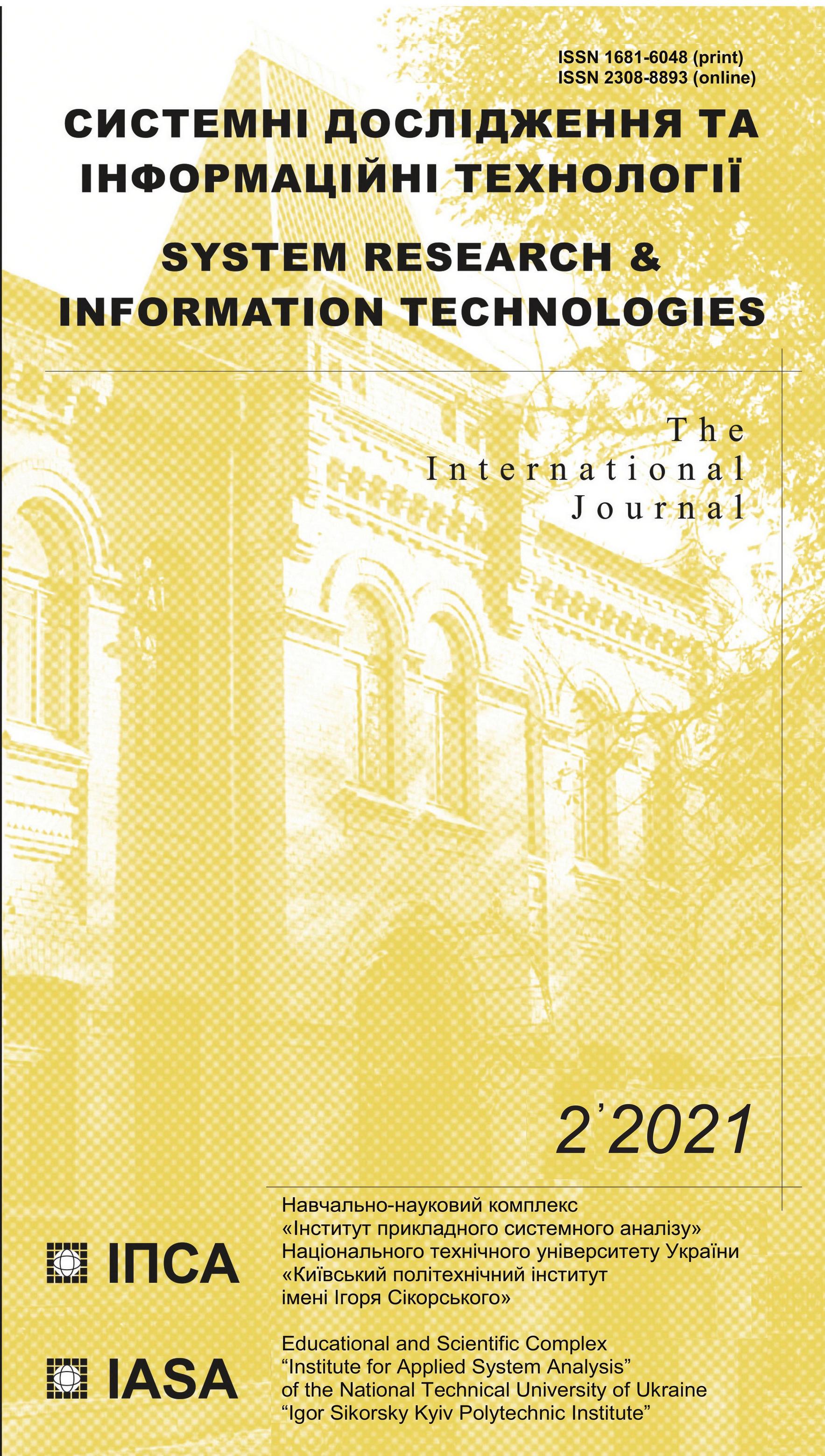Attracting sets for one class of asymptotically compact systems with pulsed perturbation
DOI:
https://doi.org/10.20535/SRIT.2308-8893.2021.2.11Keywords:
dynamical system, attractor, impulse perturbation, wave equationAbstract
The authors consider the pulsed dynamical systems generated by evolutionary processes. The trajectories of these processes undergo the pulsed perturbation when the energy functional reaches some fixed limit value. The generalization of the classical theory of global attractors of infinite dimensional dynamical systems in case of systems with impulse actions is carried out. It is established that for the dissipative pulsed dynamical system generated by the asymptotically compact semigroup, there exists a uniform attractor, i.e., a compact uniformly attracting set, minimal among all such sets in the phase space of the system. The result is applied to the weakly nonlinear wave equation with dissipation, the trajectories of which are subjected to impulsive perturbations upon attainment of a certain fixed subset in the phase space, so called the impulse set.
References
A.M. Samoilenko and N.A. Perestyuk, Impulsive differential equations. Kyiv: Vysch. shkola, 1987, 287 p.
V. Lakshmikantham, D.D. Bainov, and P.S. Simeonov, Theory of Impulsive Differential Equations. Singapore: World Scientific, 1989, 288 p. Available: https://doi.org/10.1142/0906
A.M. Samoilenko and N.A. Perestyuk, Impulsive differential equations. Singapore: World Scientific, 1995, 462 p.
M. Akhmet, Principles of Discontinuous Dynamical Systems. New York: Springer, 2010, 176 p. doi: 10.1007/978-1-4419-6581-3.
S.K. Kaul, “Stability and asymptotic stability in impulsive semidynamical systems”, Journal of Applied Mathematics and Stochastic Analysis, vol. 7, no. 4, pp. 509–523, 1994. Available: https://doi.org/10.1155/S1048953394000390
K. Ciesielski, “On Stability in Impulsive Dynamical Systems”, Bulletin of the Polish Academy of Sciences Mathematics, vol. 84, no. 1, pp. 81–91, 2004. doi: 10.4064/ba52-1-9.
E.M. Bonotto, “Flows of characteristic 0+ in impulsive semidynamical systems”, Journal of Mathematical Analysis and Applications, vol. 332, pp. 81–96, 2007. doi: 10.1016/j.jmaa.2006.09.076.
R. Temam, Infinite-Dimensional Dynamical Systems in Mechanics and Physics. Springer, 1988, 500 p. Available: https://doi.org/10.11540/bjsiam.1.4_350
O.V. Kapustyan, P.O. Kasyanov, and J. Valero, “Pullback attractors for a class of extremal solutions of the 3D Navier-Stokes equations”, Journal of Mathematical Analysis and Applications, vol. 373, iss. 2, pp. 535–547, 2011. doi: 10.1016/j.jmaa.2010.07.040.
M.Z. Zgurovsky, P.O. Kasyanov, and N.V. Zadoianchuk, “Long-time behavior of solutions for quasilinear hyperbolic hemivariational inequalities with application to piezoelectricity problem”, Applied Mathematics Letters, vol. 25, iss. 10, pp. 1569–1574, 2012. doi: 10.1016/j.aml.2012.01.016.
O.V. Kapustyan, P.O. Kasyanov, and J. Valero, “Structure and regularity of the global attractor of a reaction-diffusion equation with non-smooth nonlinear term”, Discrete and Continuous Dynamical Systems, vol. 34, no. 10, pp. 4155–4182, 2014. doi: 10.3934/dcds.2014.34.4155.
O.V. Kapustyan, P.O. Kasyanov, and J. Valero, “Regular Solutions and Global Attractors for Reaction-Diffusion Systems without Uniqueness”, Communications on Pure and Applied Analysis, vol. 13, no. 5, pp. 1891–1906, 2014. doi: 10.3934/cpaa.2014.13.1891.
O.V. Kapustyan, P.O. Kasyanov, and J. Valero, “Structure of the Global Attractor for Weak Solutions of a Reaction-Diffusion Equation”, Applied Mathematics & Information Sciences, vol. 9, no. 5, pp. 2257–2264, 2015. Available: http://dx.doi.org/10.12785/amis/090506.
N. Gorban and L. Paliichuk, “Uniform Global Attractor for Nonautonomous Reaction–Diffusion Equations with Carathéodory’s Nonlinearity”, Advances in Dynamical Systems and Control. Springer Series: Studies in Systems, Decision and Control, vol. 69, pp. 265–272, 2016. doi: 10.1007/978-3-319-40673-2_13.
M. Zgurovsky, M. Gluzman, N. Gorban, P. Kasyanov, L. Paliichuk, and O. Khomenko, “Uniform global attractors for non-autonomous dissipative dynamical systems”, Discrete and Continuous Dynamical Systems. Ser. B, vol. 22, iss. 5, pp. 2053–2065, 2017. doi: 10.3934/dcdsb.2017120.
M.Z. Zgurovsky, P.O. Kasyanov, N.V. Gorban, and L.S. Paliichuk, “Qualitative and quantitative analysis of weak solutions of energy-balance climate models”, Cybernetics and Systems Analysis, vol. 55, no. 4, pp. 552–560. Available: https://doi.org/10.1007/s10559-019-00164-1
N.V. Gorban, O.V. Khomenko, L.S. Paliichuk, and A.M. Tkachuk, “Long-time behavior of state functions for climate energy balance model”, Discrete & Continuous Dynamical Systems. Ser. B, vol. 22, iss. 5, pp. 1887–1897, 2017. doi: 10.3934/dcdsb.2017112.
N.V. Gorban et. al., “Uniform attractors for vanishing viscosity approximations of non-autonomous complex flows”, JODEA, vol. 26, iss. 2, pp. 1–12, 2018. doi: 10.15421/141807.
E.M. Bonotto, M.C. Bortolan, A.N. Carvalho, and R. Czaja, “Global attractors for impulsive dynamical systems – a precompact approach”, Journal of Differential Equations, vol. 259, iss. 7, pp. 2602–2625, 2015. Available: https://doi.org/10.1016/j.jde.2015.03.033
O.V. Kapustyan and M.O. Perestyuk, “Global Attractors in Impulsive Infinite-Dimensional Systems”, Ukrainian Mathematical Journal, vol. 68, pp. 583–597, 2016. Available: https://doi.org/10.1007/s11253-016-1243-0
E.M. Bonotto, M.C. Bortolan, R. Collegari, and R. Czaja, “Semicontinuity of attractors for impulsive dynamical systems”, Journal of Differential Equations, vol. 261, iss. 8, pp. 4338–4367, 2016. Available: https://doi.org/10.1016/j.jde.2016.06.024
S. Dashkovskiy, P. Feketa, O. Kapustyan, and I. Romaniuk, “Invariance and stability of global attractors for multi-valued impulsive dynamical systems”, Journal of Mathematical Analysis and Applications, vol. 458, iss. 1, pp. 193–218, 2018. Available: https://doi.org/10.1016/j.jmaa.2017.09.001
O.V. Kapustyan, M.O. Perestyuk, and I.V. Romanyuk, “Stability of Global Attractors of Impulsive Infinite-Dimensional Systems”, Ukrainian Mathematical Journal, vol. 70, pp. 30–41, 2018.
O. Kapustyan and D. Shkundin, “Global attractor of one nonlinear parabolic equation”, Ukrainian Mathematical Journal, vol. 55, no. 4, pp. 446–455, 2003.
A.V. Kapustyan, “Global attractors of a nonautonomous reaction-diffusion equation”, Differential Equations, vol. 38, no. 10, pp. 1467–1471, 2002. doi: 10.1023/A:1022378831393.
N. Gorban and P. Kasyanov, “On regularity of all weak solutions and their attractors for reaction-diffusion inclusion in unbounded domain”, Solid Mechanics and its Applications, vol. 211, pp. 205–220. doi: 10.1007/978-3-319-03146-0_15.

